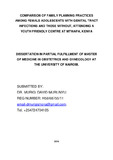| dc.description.abstract | INTRODUCTION.
Adolescents comprise about 20% of the world population with about 85% living in the developing world a significant number of whom are sexually active and have multiple sexual partners. In Kenya some have initiated intercourse by age 10 years placing them at high risk of genital tract infections including HIV, unwanted pregnancies and associated complications, genital tract malignancies among others. Information, education and counseling on family planning and more so dual protection is necessary in this age group to protect them against the above.
Objective: To compare the family planning practices among adolescents (with and without genital tract infections) attending a youth friendly center in Mtwapa Location- Kilifi County, Kenya.
Methods: This was a comparative cross sectional study on family planning practices among a total of 342 adolescents -171 with and 171 without genital tract infections(GTIs) attending a Youth friendly Centre at Mtwapa. Consecutive sampling after giving informed consent as done, data collected using structured questionnaire and entered into MS Office Excel databases using predefined questionnaire codes. Univariate and bivariate analysis of each variable was done according to the presence or/ absence of genital tract infections. Magnitude of association was reported using Odds Ratio, 95% confidence intervals and p values derived from chi square tests.
Results: Mean age of adolescents with GTIs was 17.6 years (SD 1.4) compared to 17.63 years (SD 1.5) among those without. Those with GTIs were less likely to have received formal sex education (OR = 0.27, 95% CI 0.14-0.55); more likely to have engaged in commercial sex (OR = 6.16, 95% CI 1.84-20.63); more likely to have involved in same sex acts (OR = 2.64, 1.23-5.66); used sexual performance enhancing drugs (OR = 8.51, 1.93-37.40) ; did not use condoms frequently (OR = 3.42, 1.57-7.43) and more likely to have their choice of Family planning influenced by friends (OR = 0.42;95%CI: 0.27-0.65,P<0.001) compared to those without GTIs.
Conclusions: Condoms use was less likely and friends influenced choice of family planning among adolescents with GTIs as compared to those without GTIs. In the study population, lack of and Inconsistencies of condom use, multiple sexual partners, early age at coitarche, use of sex performance enhancing drugs, same sex sexual acts, lack of formal sex education were associated with increased risk of GTIs.
ix
Recommendation: Adolescent need to be informed, educated and counseled on safe sexual practices in schools, YFCs, religious institutions by teachers, peer counselors, religious leaders respectively.
Advocacy on reducing risky sexual behavior and appropriate family planning options to protect against GTIs amongst adolescents by national and county governments should be scaled up. | en_US |
| dc.description.department | a
Department of Psychiatry, University of Nairobi, ; bDepartment of Mental Health, School of Medicine,
Moi University, Eldoret, Kenya | |


